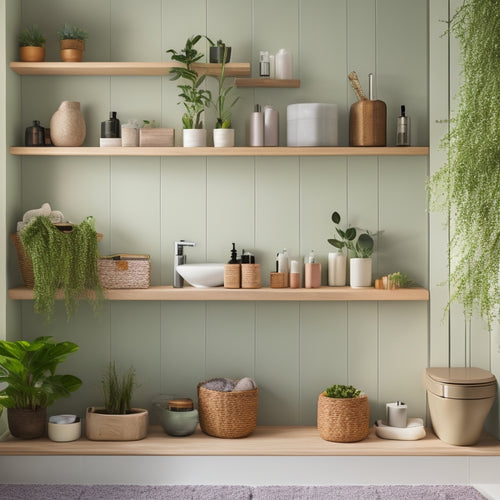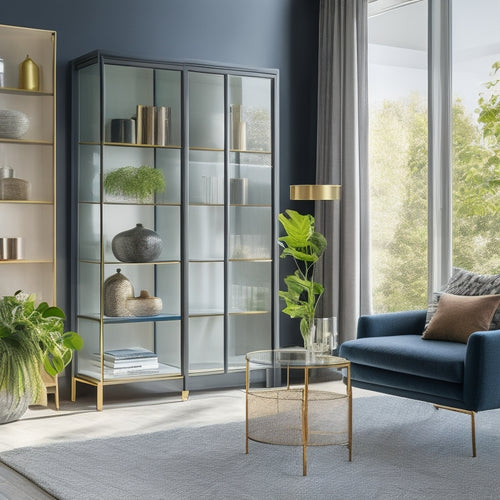
Unlock the Secrets to Perfect Cabinet Doors
Share
You're on the path to creating perfect cabinet doors when you combine quality materials, precise techniques, and attention to detail. Start by selecting straight wood and durable hardwoods like poplar or alder, ensuring high-quality materials for professional results. Next, focus on precise measurements and cuts, planning for assembly using pocket holes. Mastering routed cabinet doors involves routing rails to fit inside stiles for seamless joints and utilizing advanced routing techniques for precise cuts. By following these techniques and prioritizing precision craftsmanship, you'll discover the secrets to building flawless cabinet doors that elevate your entire cabinetry, and that's just the beginning of what you can achieve.
Key Takeaways
• Select high-quality, durable materials and ensure precise measurements for professional-looking cabinet doors.
• Master various building techniques, including constructing doors without a router and customizing designs with detailed routing.
• Route rails to fit inside stiles for seamless joints, and utilize advanced routing techniques for precise cuts.
• Ensure precision craftsmanship by measuring materials twice, cutting once, and verifying blade accuracy.
• Align rails and stiles carefully, and double-check door alignment for a perfect fit, prioritizing hardware selection and style.
Essential Tips for Cabinet Doors
To guarantee your cabinet doors turn out perfect, start by selecting straight wood to avoid warped doors, and opt for durable hardwoods like poplar or alder if budget is a concern.
When it comes to wood selection, you want to make sure that your materials are of high quality to achieve professional-looking results. Additionally, consider the importance of precise measurements and cuts, as this will impact the overall appearance of your cabinet doors.
You'll also want to plan ahead for assembly, thinking about how you'll use pocket holes to join the pieces together seamlessly. By following these essential tips, you'll be well on your way to creating stunning cabinet doors that will elevate your entire cabinetry project.
Building Cabinet Doors Techniques
When building cabinet doors, you'll need to master various techniques, including constructing doors without a router and creating doors with simple routing or detailed routed cabinet doors.
If you don't have a router, don't worry - you can use router alternatives like a saw and Kreg Jig to build doors.
For a DIY approach, you can create doors with floating center panels and join them with pocket holes on the rails.
Alternatively, you can customize your designs with creative options like detailed routed cabinet doors.
By choosing the right technique, you can achieve professional-looking results and add a personal touch to your cabinet doors.
With precise calculations and attention to detail, you'll be able to build cabinet doors that fit your style and budget.
Mastering Routed Cabinet Doors
You'll achieve a seamless, professional-looking joint by routing rails to fit inside stiles, an essential step in mastering routed cabinet doors.
To accomplish this, utilize advanced routing techniques, such as cutting precise rabbets and grooves. A router table benefits you by providing a stable and controlled environment for these cuts. With the table, you can easily set up and adjust the router bits to achieve exact results.
By routing the rails to fit snugly inside the stiles, you'll create a strong and attractive joint. This attention to detail will enhance your cabinet doors from ordinary to extraordinary.
Precision Matters in Construction
Measure your materials twice, cut once, as even the slightest miscalculation can throw off the entire cabinet door's alignment, compromising its structural integrity and aesthetic appeal.
You're not just building a door, you're crafting a work of art that demands precision craftsmanship and woodworking finesse. To achieve flawless results, verify that your blades are true, and your cuts are precise.
Calculate dimensions accurately, and don't skip the essential step of double-checking your measurements. Remember, precision is vital to a door that not only looks stunning but also functions smoothly.
Assembling the Perfect Door
To guarantee a precise fit, align the rails and stiles carefully, using a marking gauge or combination square to transfer the layout marks from your plan to the workpieces. Double-check your door alignment by ensuring the rails are parallel to each other and the stiles are perpendicular to the rails. This attention to detail will pay off in the long run.
| Hardware Selection | Door Alignment | Tips |
|---|---|---|
| Hinges | Parallel rails | Use a marking gauge for accuracy |
| Handles | Perpendicular stiles | Double-check door alignment |
| Screws | Proper rail and stile alignment | Use a combination square for precision |
When selecting hardware, consider the door's intended use and the style you're aiming for. By prioritizing door alignment and choosing the right hardware, you'll be well on your way to assembling the perfect door.
Frequently Asked Questions
What Type of Wood Glue Is Best for Cabinet Door Assembly?
'When building a bridge, you need strong foundations; similarly, when assembling cabinet doors, you need a reliable wood glue. Opt for a glue with high glue strength and excellent bond quality, like Titebond III or Franklin 500, to guarantee a durable and long-lasting joint.'
Can I Use MDF Instead of Plywood for the Center Panel?
You can use MDF for the center panel, but consider its durability and panel stability; MDF is denser than plywood, making it more prone to warping, so make sure proper support and joinery for a stable cabinet door.
How Do I Ensure Consistent Spacing Between Cabinet Doors?
To guarantee consistent spacing between cabinet doors, you'll create a spacing template, marking door alignment and measuring evenly from the cabinet frame; then, transfer the template to each door, guaranteeing precise spacing.
What Is the Ideal Door Hinge Type for Soft-Close Cabinets?
Remember the satisfaction of opening a silent, well-oiled door? You want that for your soft-close cabinets. Choose hinges with a high-quality, soft-close mechanism and durable materials, like stainless steel or heavy-duty brass, for silent operation and longevity.
Can I Add Decorative Molding to My Cabinet Doors After Assembly?
You can add decorative molding to your cabinet doors after assembly, but make sure it complements the door's design for aesthetic balance. Choose from various molding options, such as raised panels or applied molding, to enhance the visual appeal.
Related Posts
-

Wall-Mounted Shelves for Bathroom Organization
Wall-mounted shelves can completely alter your bathroom into an organized oasis. By maximizing vertical space, you cr...
-

Stylish Glass Door Storage Solutions
Stylish glass door storage solutions transform your spaces into stunning showcases. These sleek designs maximize spac...
-

Easy Tips to Resize Printables for Any Paper Size
To resize printables for any paper size, it's crucial to understand the importance of maintaining aspect ratio and pr...


